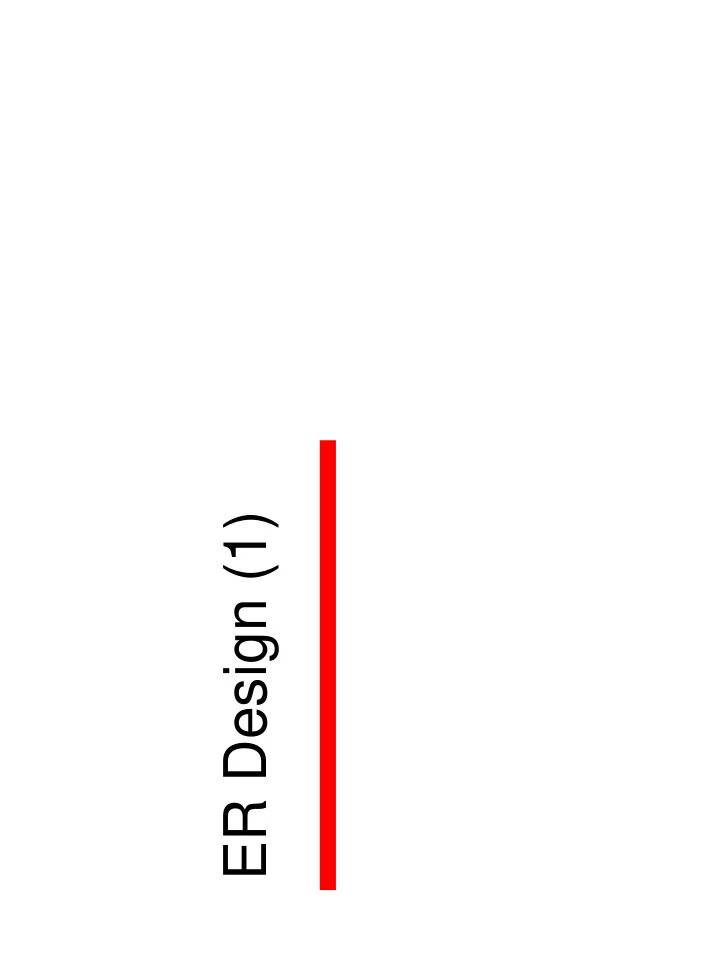

ER Design (1)
Entity-Relationship (ER) Model • Elements in a database: data entries • Data entries represent – Entities: data objects, e.g., students, courses, and instructors – Relationships among entities: students take courses, instructors teach courses • ER model: modeling data using entities and relationships CMPT 354: Database I -- ER Design (1) 2
E-R Diagrams • Rectangles represent entity sets • Diamonds represent relationship sets • Lines link attributes to entity sets and entity sets to relationship sets • Ellipses represent attributes – Double ellipses represent multivalued attributes – Dashed ellipses denote derived attributes • Underline indicates primary key attributes CMPT 354: Database I -- ER Design (1) 3
Example CMPT 354: Database I -- ER Design (1) 4
Involving One Entity Set Twice • Ann and Bob are employees in SmallCompany – Two entities in entity set employee • Ann is Bob’s supervisor – (Ann, Bob) ∈ supervision – Relationship set supervision involves entity set employee twice – How can we call the first employee and the second employee in a supervision relationship? CMPT 354: Database I -- ER Design (1) 5
Roles • The labels “manager” and “worker” are called roles; they specify how employee entities interact via the works_for relationship set • Role labels are optional, and are used to clarify semantics of the relationship CMPT 354: Database I -- ER Design (1) 6
Keys and Mapping Cardinality • One to one relationship set – Use a candidate key in either entity set – University-president(university, president) • Many to one relationship set – Use a candidate key in the one side entity set – Teaching (instructor, courses) • Many to many relationship set – Use a candidate key in each participating entity set – Take-course(student, course) • How to annotate cardinality constraints in ER diagram? CMPT 354: Database I -- ER Design (1) 7
Cardinality Constraints • Drawing either a directed line ( → ), signifying “one,” or an undirected line (—), signifying “many,” between the relationship set and the entity set. • One-to-one relationship – Each customer can have at most one loan – Each loan is associated with at most one customer CMPT 354: Database I -- ER Design (1) 8
One-To-Many Relationship • In the one-to-many relationship a loan is associated with at most one customer via borrower, a customer is associated with several (including 0) loans via borrower CMPT 354: Database I -- ER Design (1) 9
Many-To-One Relationships • In a many-to-one relationship a loan is associated with several (including 0) customers via borrower, a customer is associated with at most one loan via borrower CMPT 354: Database I -- ER Design (1) 10
Many-To-Many Relationship • A customer is associated with several (possibly 0) loans via borrower • A loan is associated with several (possibly 0) customers via borrower CMPT 354: Database I -- ER Design (1) 11
Participation of an Entity Set • Total participation (indicated by double line): every entity in the entity set participates in at least one relationship in the relationship set – E.g., participation of loan in borrower is total: every loan must have a customer associated to it via borrower • Partial participation: some entities may not participate in any relationship in the relationship set – Example: participation of customer in borrower is partial CMPT 354: Database I -- ER Design (1) 12
Entity Sets or Attributes • The structure of the enterprise being modeled • The semantics associated with the attribute in question CMPT 354: Database I -- ER Design (1) 13
Entity Sets or Relationship Sets • Designate a relationship set to describe an action that occurs between entities CMPT 354: Database I -- ER Design (1) 14
A Ternary Relationship CMPT 354: Database I -- ER Design (1) 15
A Cardinality Constraints B C • At most one arrow out of a ternary (or greater degree) relationship to indicate a cardinality constraint – An arrow from works_on to job indicates each employee works on at most one job at any branch • Confusion with more than one arrow – Each A entity is associated with a unique entity from B and C (i.e., a combination of B and C), or – Each pair of entities from (A, B) is associated with a unique C entity, and each pair (A, C) is associated with a unique B CMPT 354: Database I -- ER Design (1) 16
Binary vs. Non-Binary Relationships • Some non-binary relationships may be better represented using binary relationships – E.g. A ternary relationship parents, relating a child to his/her father and mother, is best replaced by two binary relationships, father and mother • Using two binary relationships allows partial information (e.g. only mother being know) • But there are some relationships that are naturally non-binary, e.g., works_on CMPT 354: Database I -- ER Design (1) 17
Converting Non-Binary Relationships • A non-binary relationship can be represented using binary relationships by creating an artificial entity set – Replace R between entity sets A, B and C by an entity set E, and three relationship sets: CMPT 354: Database I -- ER Design (1) 18
Summary • Roles • Cardinality constraints • Participation • Choice of entity sets attributes, or relationship sets • Binary and non-binary relationships CMPT 354: Database I -- ER Design (1) 19
To-Do-List • Can you think about some situations where the facilities of ER design we have so far are still insufficient to model the application data? CMPT 354: Database I -- ER Design (1) 20
Recommend
More recommend